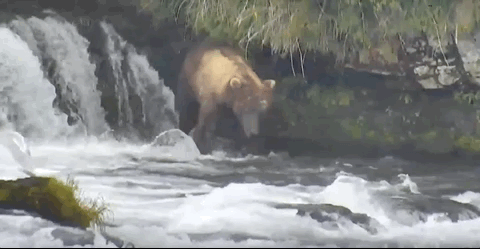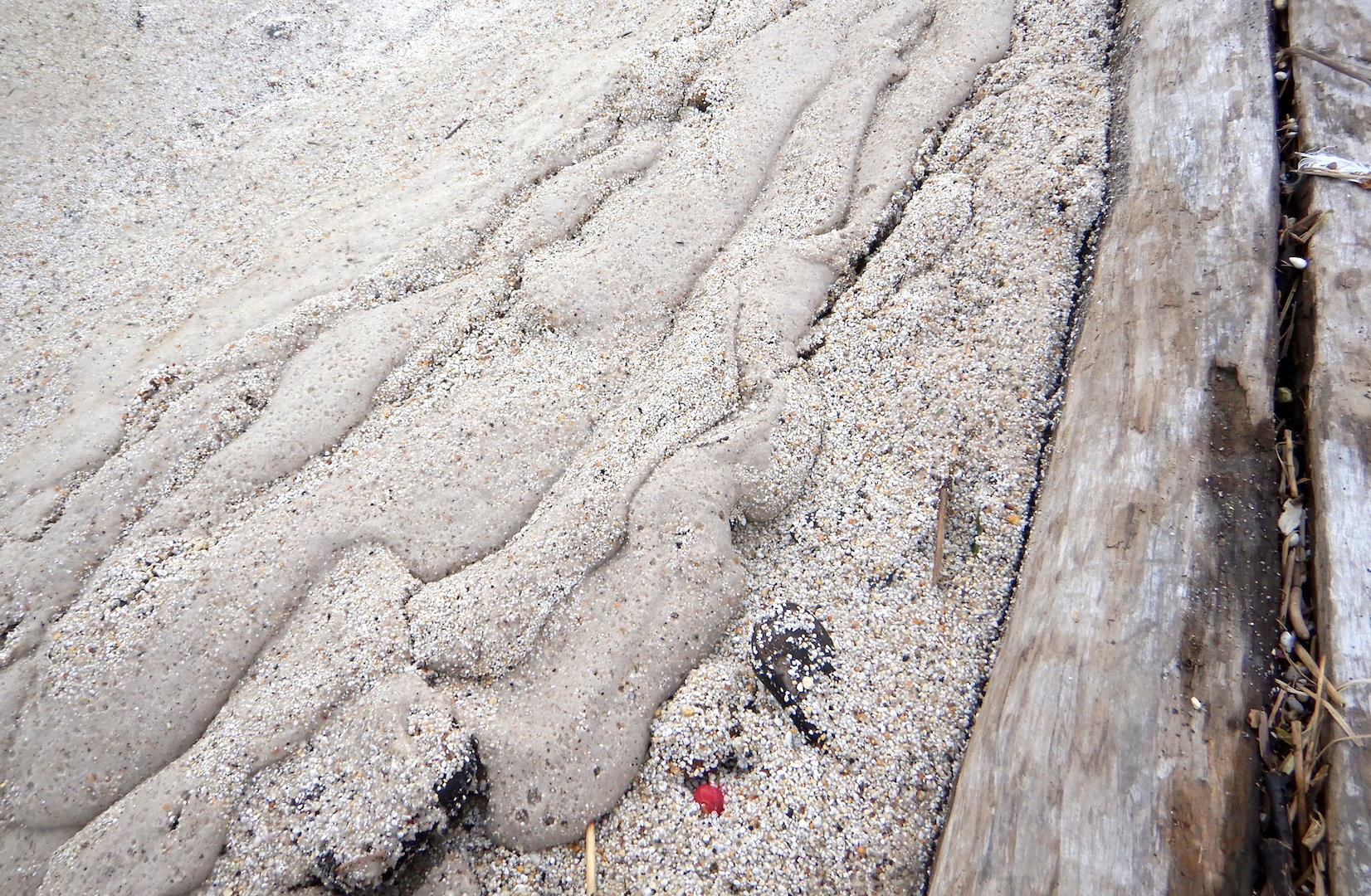In September 2017, I took a brief trip to Brooks Camp, the world-famous bear-viewing site in Katmai National Park. This was a rare opportunity for me to visit for fun, as opposed to traveling there to work for the National Park Service or explore.org.
Bear watching is the most popular human activity at the river and the close proximity of Brooks River’s brown bears to the designated wildlife-viewing platforms makes for some exceptional photographic opportunities. However, I toted only a small point and shoot camera with a limited zoom. Taking good photographs, therefore, was challenging so I focused more on recording video of bears. Video can also provide a sense of scale that is sometimes difficult to capture in photos, especially when a titan is in the vicinity.
On the last morning of my trip, I found the colossal 747 walking out the river to challenge a competitor at Brooks Falls. This is what happened.
After I uploaded this video to YouTube, I hadn’t expected it to garner much attention, but a little more than three years later Giant Fat Bear at Brooks Falls is approaching one million views and has generated more than 3,500 comments.
When a video goes viral or becomes modestly popular, you can either let it develop a life of its own or attempt to heighten the experience. A captivating video is a chance to give people more than a few seconds of entertainment. It presents an opportunity.
People are naturally curious, especially so toward animals, but context and relatable, meaningful information are often needed to match that curiosity. How might those in the fields of heritage interpretation or science communication provide the casual viewer with a more meaningful experience? Here are a few of the strategies that I found successful with a short video about a fat bear.
Anticipate what a person with no context of the place or subject might need to know. The universe is a big place. Put yourself in the mindset of someone who does not have your experience or background. Although people relate to brown bears easily and on many levels (they definitely love a chonky bear), the natural history and ecology of these animals are not universally or even well known. I soon realized my modest video description was inadequate. Viewers were drawing conclusions and asking questions that I had not anticipated. They wanted to know more.
Get to know the demographics of your audience. If you read this blog regularly, you’re familiar with the bearcams in Katmai National Park. While the bearcams are extremely popular, receiving tens of millions of views each year, explore.org’s webcam analytics document that the bearcam audience skews heavily toward the female gender and adults over the age of 45. Analytics on Giant Fat Bear at Brooks Falls, however, are much different. Viewers are typically 18 – 35 years old and overwhelming male.

That audience will likely react to and evaluate information differently than the typical bearcam commenter. And, they are relating to different things in the bear world. Knowing that, I might respond to questions and comments on the video in ways that I wouldn’t during a live chat on the bearcams.

If a video generates a lot of similar questions or leads people to make assumptions, write an FAQ to address those and then put it some place obvious. When the views on Giant Fat Bear at Brooks Falls began to skyrocket, I took mental notes on the questions it generated to see if there was a pattern, while keeping in mind that the internet is a big place where people from all over the world can access the video. In addition to the questions people were asking, the number of comments prompted me to consider how I could provide further context. I identified three questions originally, wrote concise answers for them, and pinned the FAQ to the top of the video comments.
The FAQ didn’t stop people from asking questions (and I didn’t it want it to), but it caused the queries to change. Questions became less repetitive. They branched to other facets of bear biology. Plenty of people appear to be reading the FAQ as well. As of this writing, the FAQ on Giant Fat Bear has 2.8 thousand likes and zero dislikes.
The FAQ proved to be particularly valuable in ways that I did not expect. Much of the internet is little more than websites recycling (to state it mildly) the work of others. When the video first began to trend in 2018, the FAQ was often the only source of info used by websites looking to generate click-bait content based off my video. It was used in the prestigious Daily Mail, for example, to produce one of the tabloid’s most fact-laden articles ever.
When in doubt, assume that a person asks questions in good faith. It’s not always easy to discern the difference between questions asked in good or bad faith, and trolls should not be engaged. However, each person experiences life through the lens of a unique worldview and knowledge base. Furthermore, access to open space and outdoor recreation (both physically and inclusively) is far too limited for many people, especially among those that experience racism and discrimination. Yet biophilia and an instinctual curiosity reverberates through each of us, and by asking a question a person signals that they want to learn.
This is why I included “Are you making fun of the bear’s fatness?” in the FAQ. It’s not dumb to not know much about bears. Most of us don’t have easy access to bear habitat, let alone the opportunity to observe wild bears. People also post a lot of offensive stuff online. Given the unfortunate status quo of social media, I don’t fault anyone for thinking I might’ve been making fun of a fat bear instead of simply describing him. It is not obvious to everyone that bears must get fat in order to survive.
Think carefully about offers to license your content. Video distribution agencies prowl social media sites looking for engaging videos to add to their collections. Their offers to license and distribute your video look appealing at first glance, but I eventually rejected them all. Providing meaningful information and context was more valuable to me than the ten cents I might make through a third party distributor. I was particularly hesitant because some viral media companies distribute wildlife videos and spread them without context or even checking to see that video was recorded ethically. By rejecting these solicitations, I sacrificed reach but remained in control of the flow of information.
Lastly, choose a catchy title for your video but also one that isn’t confusing. Some comments on Giant Fat Bear at Brooks Falls suggest that a handful of people read the title literally and expected to see a giant fat bear fall.

I’ve greatly enjoyed seeing how this simple video has inspired interest in bears, art, memes, and eventually helped to propel 747 to Fat Bear Week greatness.
As I draft this post, Giant Fat Bear continues to generate questions and comments. Many of the comments are simple jokes, but I still count those as a win. It means that a person was engaged. For those few seconds (and more if they asked a question) they were thinking about bears.


![Screen shot of youtube comment. Text says, "Gladhe 1 month ago He protecc He attacc He most importantly Eat big mac!]](https://fitznaturalist.files.wordpress.com/2021/01/screen-shot-2021-01-22-at-9.03.55-pm-1-e1611675551409.png)
I have no allusion that leaving a comment on a video is the same as stewardship and advocacy for wild animals. But the first step towards stewardship is awareness and understanding. As Freeman Tilden, the founder of modern heritage interpretation, wrote in Interpreting Our Heritage, “Through interpretation, understanding; through understanding, appreciation; through appreciation, protection.” We get there one step at a time and we get there more easily with guides along the way.


























